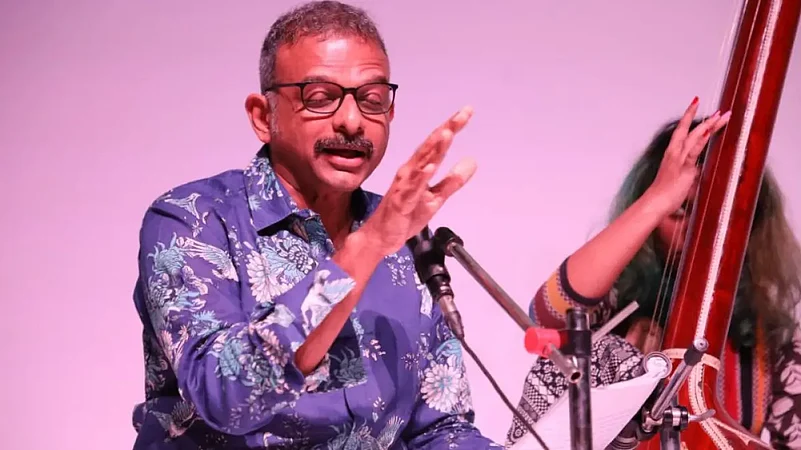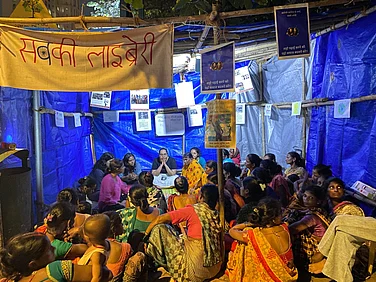Rendering songs in a language that has never been used for millenia is quite a task. No musical history to look back or the raga, ie, melodic framework in Indian classical music to fall back upon in order to reveal the intended meaning and emotions the words evoke, is a demanding task. Carnatic musician and author T.M. Krishna, in a recent event in Sonipat, Haryana, attempted that by singing the edicts of Mauryan emperor Ashoka. With his erudition and vast knowledge, the Ramon Magsaysay awardee offered an enjoyable interpretation of these decrees.
Most of Ashoka’s edicts are in Prakrit language, a group of vernacular Middle Indo-Aryan languages. Krishna said he found this language mired in complexities from its many variances, as Prakrit was a regional, spoken language, as opposed to Sanskrit, which literally means “refined”. Prakrit is characterised by extension of vowels, and has not been musically explored a lot, especially in the modern era.
Therefore, sharing his experiences of singing Ashoka’s edicts, Krishna says he didn’t find a reference point to start with, as, “Prakrit, has, to my knowledge, not been sung," he says. “Though these words are powerful, my language of expression is primarily music. Saying a word is different from singing a word – the syllable, sounds of a word, flow, everything changes. So, singing these edicts was difficult, but fascinating. For a long time, I simply kept reading these edicts.”
“There is no standard Prakrit.” Like for instance in Magadhi Prakrit – a form of Prakrit associated with the Magadha kingdom. “There are variances in edicts. Therefore, we collectively decided to retain these variances, because that is what gives it a cultural context. And we explored musicality with these variances.” That in itself sets another limitation.
Talking about how he got interested in Ashoka’s edicts, Krishna says Gopalkrishna Gandhi suggested that he re-read these edicts. “It was like I was hearing myself having those conversations, sometimes those conflicts, and I realise, it was relevant for us to think in that manner,” he says.
Ashoka was not just a king who existed in the Indian subcontinent between 304-232 BC. His teachings and decrees form an important part in the social and cultural imagination of the Indian subcontinent. Unlike his predecessors of the Mauryan empire, Ashoka made sure to use his power by reaching out to his subjects in a more robust manner, and ensured his messages remain alive for posterity, thus engraving his thoughts and decrees on the edicts was no coincidence, but a deliberate attempt.
Krishna and Nayanjot Lahiri, Professor of History at Ashoka University, therefore decided to work together on The Edict Project, to reimage and remember Ashoka. Lahiri believes, “there is a difference between historical Ashoka, and remembrance of Ashoka.” To understand him after so many years is difficult, because historians only had epigraphic sources to look back upon and make sense. Therefore, the project re-conceives him, through various approaches, music being one of these. A movie by actor and director M.K. Raina, in which two protagonists reimagine Ashokan rule in today’s Kashmir, is another such attempt.
Ashoka’s life was quite unusual to his time. In the public imagination of Ashoka, the Kalinga war – fought between the Mauryan Empire under Ashoka and the state of Kalinga – played a crucial part in the metamorphosis of the king. This is how he is remembered, a monarch whose heart changed after seeing destruction inflicted by his unwavering desire to expand his kingdom. Thus, he conceded moral defeat, even after winning the war.
Even though Kalinga was an important part in the life of Ashoka, but, there are no edicts featuring the Kalinga war in Kalinga. Though there is a controversy around the exact reason for it, Nayanjot Lahiri, Professor of History at Ashoka University, believes it was perhaps “deliberate”.
Ashoka was trying to make amends. "He realises that rubbing salt on fresh wounds is not a good policy. He saw the Kalinga war as a moral defeat. While, during his times, kings of West Asia were boasting about ruthless victories in war, like “Persian monarchs were constantly talking about heads they cut off, and kings they defeated. It is in their relief panels and sculptures and so on and so forth,” says Lahiri. She believes that he was a monarch, and every monarch has an agenda. Even then, here was the king who was acknowledging that he committed a great sin, and that he was trying to make up for it.
Kalinga features in one of his major rock edicts, it was not the first set of his words. It’s just that he took his time to come to terms with the bloodshed to be able to talk about it. He won the war but the collateral damage, which he was upfront about, made him see it as a moral defeat. His edicts in Kalinga, Lahiri says, “have to be seen, in a sense that, he is trying to public outreach, and trying to make awareness".
However, his sense of remorse doesn't make him a monk. Krishna says, “There is a complexity. The struggle of ethics and power is very important in Ashoka’s life. How a monarch is dealing with his own guilt and how he is trying to act in public is interesting.” But he still was a monarch, he knew he wields power. Explaining that Lahiri says, “Ashoka had a robust ego. He talks about his queen, Karuvaki, having made donations, and he is telling his officials she wants to register them. He is also strict on the sanghas (monastic order). He told them not to fight among each other, otherwise they would be cast out.”
Interestingly, Ashoka did not talk about his lineage. “He was not the eldest son of Bindusara, so he literally snatched the throne. So, in such a situation, you don’t talk about your lineage. But, again this is a complex situation. There is no simplistic way of looking at it.” adds Lahiri.
There are also variations in the kind of language used in edicts. Explaining it, Lahiri gives an example of edicts in Afghanistan, “Ashoka is not sounding tentative about his progression. He is saying, I want all meat eating and all hunting to stop and now hunters have stopped hunting and fishermen have stopped fishing, not the kind of thing you will find, in the parts of India as it were.” She adds, “It also gives a sense that the administration had the agency so the officials must have decided it. Things are proclaimed, considering Afghanistan in relation to West Asia, Persia.” Here, everything is proclaimed in this very bombastic way. Moreover, Ashoka wanted his subject to remember his words and decrees so much so, that like religious leaders on a podium, he repeated himself again and again to embed certain things in public memory.





















